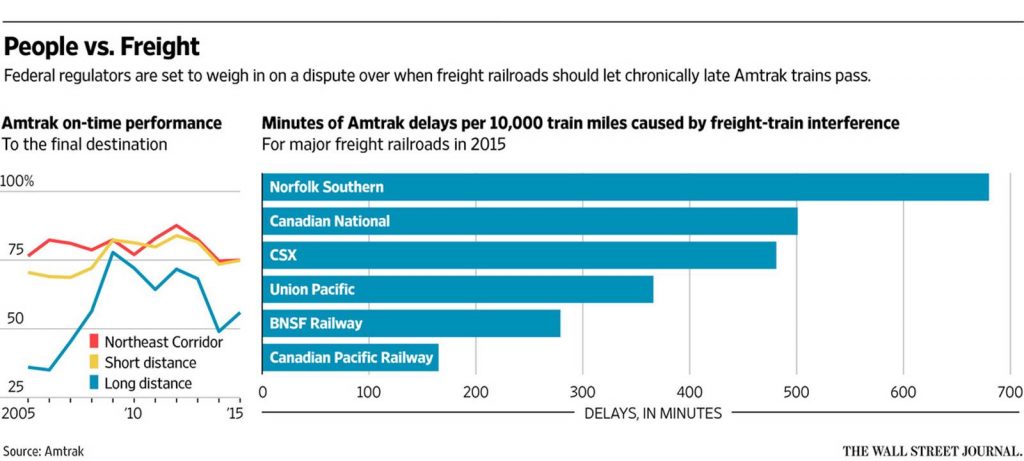Amtrak Trains Fight to Go First: Freight railroads are pushing federal regulator to change rule giving passenger trains priority over cargo trains
By Laura Stevens and Andrew Tangel
The Wall Street Journal
May 22, 2016 7:15 p.m. ET
Which train should go first—an Amtrak passenger train or a cargo train? That’s the question federal regulators are trying to resolve.
For more than 40 years, Amtrak says it has had the right to go first under law, meaning freight railroads have to pull over their trains whenever possible to let a passenger train pass or hold their trains in station to prioritize an Amtrak departure, except in emergencies.
Freight railroads want that to change, but Amtrak, whose long-haul national trains are chronically late, is fighting it.
“Amtrak’s not being rigid here or inflexible,” D.J. Stadtler, chief operating officer for the national passenger railroad said. “In order for the network to work for the passengers, we’ve got to have a reliable and repeatable schedule that we’re held to.”
The decision is in the hands of the U.S. Surface Transportation Board, a federal agency that regulates railroads. In December, the board said it is reviewing the existing rule and signaled that it is open to changing the current state of play. A final decision is expected in the coming weeks.
A spokesman said the board is examining the positions of parties who weighed in following the close of the commentary period in March, with no set timeline for releasing its findings.
The Association of American Railroads, which represents the major freight carriers, called on the regulator to “reject Amtrak’s attempt to radically transform operating practices through an erroneous interpretation of the preference statute” in a filing.
It comes at a pivotal moment for both industries. After a major boom in rail cargoes following the recession, volumes have dropped off in the past year as oil prices collapsed, leading to layoffs and a push for more on-time service to maintain pricing in an increasingly tough environment.
Amtrak, on the other hand, is experiencing rising ridership. The railroad overall carried nearly 31 million passengers in 2015, compared with about 25 million in 2006.
The national passenger railroad primarily only owns track for its routes in the Northeast and must otherwise work with cargo railroads for routes elsewhere in the country.
As a result, its trains run on 14% of the nation’s freight rail network, making daily trips in each direction on some long-distance routes. But Amtrak trains, which generally travel at about 80 miles an hour, often encounter slower traffic: freight railroads typically average system speeds of less than half that.
The fight boils down to the interpretation of the word “preference” in a 1973 law. A couple of years earlier, with fewer Americans traveling by rail, railroads handed over their individual passenger operations to the government.
As a condition of removing their mandate to carry passengers, Congress required permission for Amtrak to operate on their tracks, and it added: “Except in an emergency, intercity and commuter rail passenger transportation provided by or for Amtrak has preference over freight transportation in using a rail line, junction or crossing.”
In 2008, Congress added potential financial penalties into law. If Amtrak’s on-time performance was less than 80% for any two consecutive quarters on specific freight routes, the railroads could be fined.
But in December, the Surface Transportation Board said “preference” was still undefined. “Currently we do not view the preference requirement as absolute,” the board added.
The board’s initial interpretation “is in fact what is required and what is actually happening,” said Association of American Railroads President Ed Hamberger. “It’s not stripping [Amtrak] of anything.”
While Amtrak says preference means it gets to go first, in nearly all circumstances, freight railroads define the word preference as balancing Amtrak’s needs with their own. That means that weather, unexpected traffic, maintenance and other factors could result in the need to send a freight or repair train first, while still trying to keep Amtrak on time.
Freight railroads argue they need flexibility. On a route with 100 freight trains a day, there aren’t enough side tracks on which to pull over in favor of Amtrak, Norfolk Southern Corp. NSC -0.09 % said in a filing with the Surface Transportation Board.
“Having Amtrak always hold the main track soon would result in Amtrak ending up nose-to-nose with another train and that section of the network would grind to a complete halt,” the railroad added.
Freight railroads experience different rates of getting Amtrak to its destinations on time.
Canadian Pacific Railway Ltd. CP -0.72 % and BNSF Railway Co. post some of the best on-time results, under 300 minutes of Amtrak delays per 10,000 miles in 2015. Norfolk Southern came in last, causing Amtrak to wait 680 minutes per 10,000 miles, according to Amtrak. The railroad has since moved out of last place.
A Norfolk Southern spokeswoman declined to comment. Some railroads argue that Amtrak’s methods of calculating delays can be misleading, giving more weight to small delays along short sections of tracks.
Amtrak says it is about getting passengers to their destination on schedule, keeping riders happy.
“Blueberry muffins always taste better when the train’s on time,” said Amtrak’s Mr. Stadtler, referring to an old saying inside the railroad.




